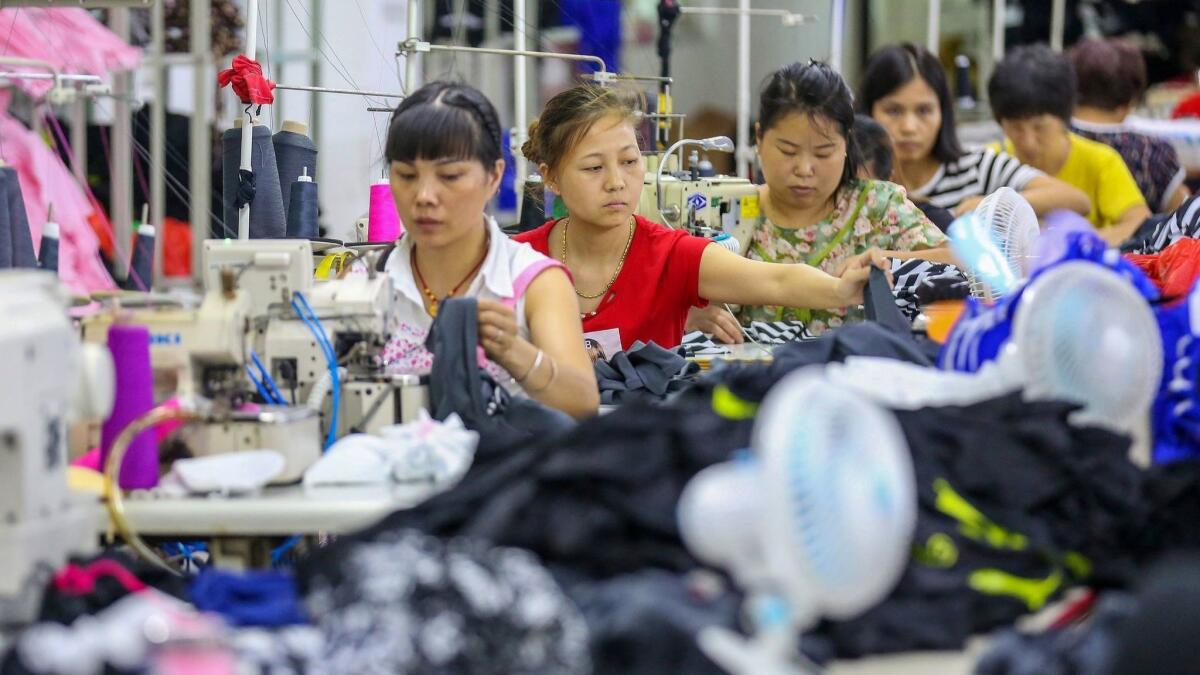China targets $60 billion of U.S. goods as two sides dig deeper on trade war

- Share via
The trade war between the world’s two biggest economies is taking on a life of its own.
When President Trump first threatened to slap tariffs on Chinese goods in March to punish Beijing for stealing American intellectual property, trade experts warned the two nations risked slipping into a downward spiral of tit-for-tat trade actions. The global economy now appears to be living that reality, with the trade war settling into a regular rhythm of counterblows.
The latest shot came Friday, when China released a list of $60 billion in U.S. goods that Beijing intends to hit with tariffs in retaliation for Trump’s plan to impose duties on $200 billion in Chinese imports. While the Chinese threat isn’t proportional in absolute dollars, it’s actually an escalation on a relative basis, given China buys less from the U.S.
Within hours, White House economic advisor Larry Kudlow promised Trump wouldn’t back down until China changed its trade practices. “Don’t underestimate President Trump’s determination to follow through,” Kudlow told Bloomberg Television in an interview.
They keep digging the hole deeper, violating the first rule of holes, which is when you’re in one, stop digging.
— William Reinsch, Center for Strategic and International Studies
“They keep digging the hole deeper, violating the first rule of holes, which is when you’re in one, stop digging,” said William Reinsch, a trade expert at the Center for Strategic and International Studies who worked at the Commerce Department during the Clinton administration.
Hopes had been rising that Trump might drop his trade-war campaign after the president announced a deal last week with European Commission President Jean-Claude Juncker that would see the U.S. and European Union cut tariffs and other barriers.
There are also signs the Trump administration is trying to revive formal negotiations with Beijing. There’s “some hint” the Chinese may be warming to the idea, and recently there’s been some communications at the highest levels of both governments, Kudlow said. A White House spokeswoman said the administration remains open to further talks.
But finding common cause with Europe is one thing. America’s differences with China, a one-party state that has promised to open its markets gradually, run deep.
U.S. Trade Representative Robert Lighthizer last week called trade tensions a “chronic problem” that would likely take years to resolve. Kudlow cited state subsidies and forced technology transfers as behaviors that the Trump administration wants China to end.
Earlier this week, the U.S. said it was considering more than doubling to 25% the tariffs for the $200 billion in Chinese imports that are under public review.
The conflict with China is taking on a “cyclical” pattern with roughly two weeks of escalation followed by two weeks of relative calm, said Mark Rosenberg, chief executive at Geoquant Inc., a firm that uses computer models to gauge political risk.
“These two sides effectively have equal leverage over one another,” Rosenberg said. “No one has a real incentive to blink first. That suggests this is going to be a more protracted conflict.”
The question is what other tools the two countries may use, once they have no more goods upon which to impose tariffs. The U.S. imported $506 billion in goods from China last year, and Trump has threatened to slap duties on effectively all imports from the Asian nation. China imported $130 billion in goods from the U.S. in 2017, according to U.S. figures.
Currencies would be one option. Kudlow suggested Friday that China is letting its currency fall to offset losses from the trade war, though he added that the decline is partly due to weak economic fundamentals. The People’s Bank of China stepped in to support the yuan on Friday after the currency slid to the lowest level in more than a year.
In the meantime, signs of the trade war are creeping into the economic data. U.S. manufacturers are considering expanding outside the country to avoid the widening trade conflict, according to the Institute for Supply Management’s July survey. Such sentiment may weigh on business investment, which contributed last quarter to the fastest pace of growth in four years.
The Trump administration may be overestimating its ability to pressure Beijing into changing its economic behavior, said Stefan Selig, managing partner at BridgePark Advisors LLC and former trade undersecretary at the Commerce Department under President Obama. China’s one-party system gives President Xi Jinping several advantages in a trade war, such as the ability to control the nation’s media, Selig said.
“It’s such a fundamental miscalculation that the Chinese are going to buckle,” Selig said.
UPDATES:
1:30 p.m.: This article was replaced with a Bloomberg version.
7:20 a.m.: This article was updated to include additional items on the list and background information.
This article was originally published at 6:35 a.m.
More to Read
Inside the business of entertainment
The Wide Shot brings you news, analysis and insights on everything from streaming wars to production — and what it all means for the future.
You may occasionally receive promotional content from the Los Angeles Times.








